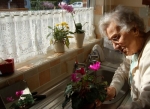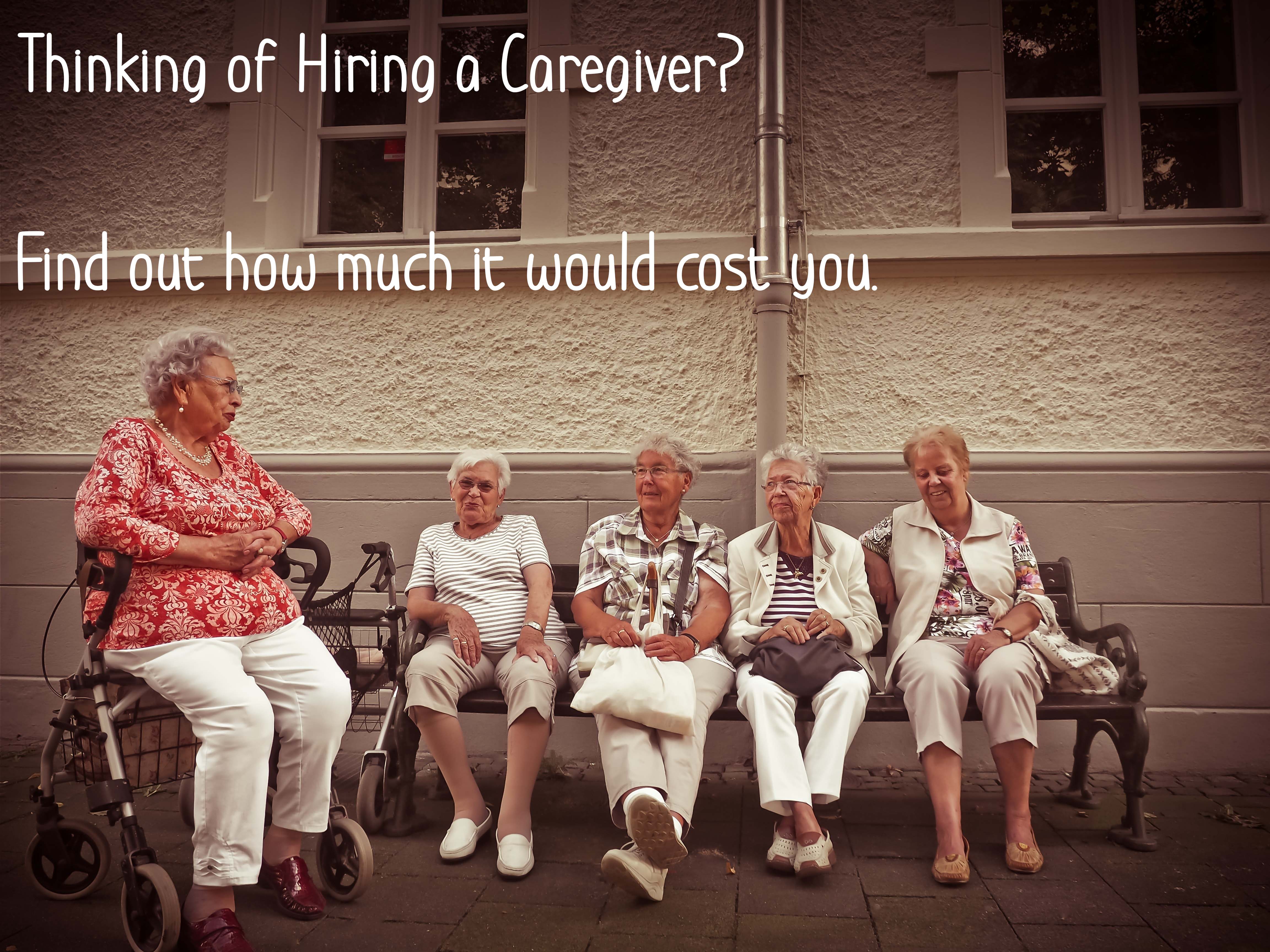Monitoring Devices Help Elderly Stay at Home
 In the wee hours of July 14, Elizabeth Roach, a 70-year-old widow, got out of bed and went to the living room of her Virginia ranch home. She sat in her favorite chair for 15 minutes, then returned to bed.
In the wee hours of July 14, Elizabeth Roach, a 70-year-old widow, got out of bed and went to the living room of her Virginia ranch home. She sat in her favorite chair for 15 minutes, then returned to bed.
She rose again shortly after 6, went to the kitchen, plugged in the coffee pot, showered and took her weight and blood pressure. Throughout the morning, she moved back and forth between the kitchen and the living room. She opened her medicine cabinet at 12:21 and closed it at 12:22. Immediately afterward, she opened the refrigerator door for almost three minutes. At 1:36, she opened the kitchen door and went outside.
All this information — including her exact weight (126 pounds) and blood pressure reading (139/98) — was transmitted via the Internet to her 44-year-old son, Michael Murdock, who reviewed it from his home office in suburban Denver.
All was normal — meaning all was well.
“Right now she’s not home,” Mr. Murdock said. That he deduced because the sensors he had installed throughout his mother’s home told him that the kitchen door — which leads outside — had not been reopened since 1:36, more than an hour earlier. The opening of the medicine cabinet midday confirmed to him that his mother had taken her medicine. And he was satisfied that she had eaten lunch because the refrigerator door was open more than just a few seconds.
In the general scheme of life, parents are the ones who keep tabs on the children. But now, a raft of new technology is making it possible for adult children to monitor to a stunningly precise degree the daily movements and habits of their aging parents.
The purpose is to provide enough supervision to make it possible for elderly people to stay in their homes rather than move to an assisted-living facility or nursing home — a goal almost universally embraced as both emotionally and financially desirable. With that in mind, a vast spectrum of companies, from giants like General Electric to start-ups like iReminder of Westfield, N.J., which has developed a system to notify families if loved ones haven’t taken their medicine, are looking for a piece of the market of families with an aging relative.
Many of the systems are godsends for families. But, as with any parent-child relationship, all loving intentions can be tempered by issues of control, role-reversal, guilt and a little deception — enough loaded stuff to fill a psychology syllabus. For just as the current population of adults in their 30s and 40s have built a reputation for being a generation of hyper-involved, hovering parents to their own children, they now have the tools to micro-manage their aging mothers and fathers as well.
Wendy A. Rogers, a psychology professor at Georgia Tech, who has studied such systems and seniors’ reactions to them, recalled a man who went into high alert when a sensor system showed a high level of activity in a room of his mother’s home. He called her to find out what was wrong — and it turned out that she had decided to paint the sunroom.
“I think the critical question is: Is this something the parent wants?” said Nancy K. Schlossberg, a counseling psychologist and professor emerita at the University of Maryland. She compared monitoring technology for elderly people to the infamous “nanny cams” — hidden cameras some parents use to spy on their children’s baby sitters. “Big Brother is watching you — there’s something about it that’s very offensive,” she said.
The decision, she said, must ultimately be made by the aging parent. “It has to be negotiated with the parents,” Dr. Schlossberg said. “You want to keep the relationship co-equal. If it’s not an agreement with the parent, it can be a very destructive thing.”
The system Mr. Murdock persuaded his mother to install is called GrandCare, produced by a company of the same name based in West Bend, Wis. It allows families to place movement sensors throughout a house. Information — about when doors were opened, what time a person got into and out of bed, whether there’s been any movement in a room for a certain time period — is sent out via e-mail, text message or voice mail. He said his GrandCare system cost $8,000 to install — about as much as two months at the local assisted-living facility, Mr. Murdock said — plus monthly fees of about $75. The company says that costs vary depending on what features a client chooses.
In addition to giving him peace of mind that his mother is fine, the system helps assuage that midlife sense of guilt. “I have a large amount of guilt,” Mr. Murdock admitted. “I’m really far away. I’m not helping to take care of her, to mow her lawn, to be a good son.”
His mother, Mrs. Roach, was nervous at first when her son brought up the idea of using the system. “I didn’t want to be invaded,” she said. “I didn’t understand the system and was concerned about privacy.” Now that it’s in place, she said, she’s changed her mind: “I was all wrong. I’m not feeling like I’m being watched all day.” And she really enjoys the system’s feature that lets her play games and receive photos and messages from her children and grandchildren. (She never learned to use e-mail.)
Mrs. Roach has no major health issues that require the kind of watching she is getting, and oddly enough, that is the ideal scenario. Elinor Ginzler, senior vice president for livable communities at AARP, said it’s best to discuss using such technology long before a parent’s health has slipped to a point where she might actually need it. “You frame it that way: ‘We’re so happy that things are going so well. We want to make sure to keep it that way. Let’s talk about what we can do to make sure.’ ”
What often follows is pushback. After all, this is not a generation known for its ease with technology.
“My parents’ first reaction to technology is, ’Get it away from me,’ ” said Rachel Meyers, 45, of Brooklyn, whose father, an 80-year-old retired math professor, put at the top of his course syllabus each year: “Do Not E-mail Me.” When her mother, who just turned 84 and lives with her husband in Minneapolis, developed kidney disease, Rachel and her far-flung siblings worried about how to ensure that she was taking the complicated regimen of pills needed daily for her condition.
Their father was not going to be a reliable enforcer. “My father is going to be in his own cave reading a math book with his socks and sandals,” Ms. Meyers laughed. “He is not that guy.”
Through her work as director of community initiatives at the Metropolitan Jewish Health System in Brooklyn, Ms. Meyers learned about a medication management system called MedMinder. It is basically a computerized pillbox. The correct daily dosages of her mother’s 10 different medications are arranged in boxes. When it is time to take them, the pillbox beeps and flashes. If she takes them, Ms. Meyers gets a phone call in Brooklyn saying, essentially, Mom took her pills. Her siblings, including a brother who lives in Australia, get e-mail notifications.
But if her mother doesn’t take the pills within a two-hour window, the system starts nagging. It calls her. It flashes and beeps. Then Ms. Meyers gets a phone call in New York with a message saying her mother missed her dose. “So that’s been interesting,” Ms. Meyers said. “I can call and say, ‘Hey Mom, have you taken your medicine?’ She’ll say, ‘No, I’m on my way.’ I’ll say ‘Do it as a favor for me and take it while we’re on the phone.’ She’ll take it.”
Usually it all works out. But “what does get us into hairy, difficult emotional ground,” Ms. Meyers said, is when her mother’s daily routine changes and her children neglect to reprogram the pillbox to keep up with the shift. For example, as the dialysis began taking a toll, her mother began sleeping later in the morning, but the MedMinder still expected her to take her pills at 7.
“The machine is beeping and she’s not up yet,” Ms. Meyers said. “We get stuck in our own busy lives” and forget to reprogram it. “She says, ’I don’t want it any more.’ Now we’re in a defensive place.”
However, in an interview, Ms. Meyers’s mother, Harriet Meyers, said she had come to appreciate the contraption. “At first I was rebellious. I said, ‘Look, I’m lining up my pills, Rachel.’ I said, ‘I know what I’m doing.’ ” But now she looks at it differently. “I decided to try and now I’m hooked.”
Several academic studies have been undertaken to see just where the line between loving watchfulness and over-intrusion might be drawn. Researchers at Georgia Tech have created an experimental house (called the Aware Home) outfitted with various sensors and motion detectors as well as systems that provide support for medication and memory. They brought in older adults to see how they felt about the devices. “They were quite positive about the idea,” said Ms. Rogers, who is a director of the university’s Human Factors and Aging Laboratory. But the key, she said, is control. The older person is much more amenable if he or she “can control who has access to the information and what information they have access to,” she said.
Other research suggests that having the monitors in place may be enough to give family members peace of mind, and that they are less likely than one might expect to spend time poring over the information. Kelly Caine, a researcher at Indiana University, is just completing a study that found that for all the handwringing over whether to install monitoring technology, the people who received the information from such systems “rarely checked in on the older adults using the monitoring technology more than once per day.” The findings are preliminary, cautioned Ms. Caine, the principal research scientist at the university’s Center for Strategic Health Information Provisioning.
Adult children who call parents to check up on them have learned to be careful about how they phrase their questions. “I personally don’t make it so that I’m watching,” Mr. Murdock said. “I don’t say, ‘Mom, I was looking and you didn’t do this.’ I say, ‘Mom, are you O.K.? I noticed you didn’t take your medicine.’ It’s a balancing act, but it’s an easy conversation. It’s not like I’m calling every day saying, ‘Did you do this or did you do that?’ ”
Other families have also found that the systems reduce the need for nagging conversations. Ray Joss, 91, of Flushing, Queens, has been using a sensor-based system called QuietCare that she found through Selfhelp, a social services company in New York that helps seniors use technology to allow them to live independently. She says that she and her son, who lives in New Jersey, don’t have to dwell on her well-being in conversations because the monitoring system has already let him know how she is. “We talk about other things rather than just how I feel. He doesn’t have to ask me.”
Despite their increasing familiarity with the technology, many elderly people draw the line at cameras.
Susan Oertle has been using a wireless monitoring system called BeClose to check on her aunt, who was recently widowed and had no children of her own. Though the 83-year-old woman recently broke her hip and suffers from a lung condition that compromises her breathing, she is still fiercely independent and likes to stay up till 1:30 a.m. Thanks to wireless sensors in her aunt’s bed, Ms. Oertle can roll over in the middle of the night and notice an e-mail message flashing on her phone reassuring her that her aunt went to sleep. But enough is enough. If there had been cameras to monitor her, Ms. Oertle said, “I think she would have had a bird.”
Courtesy of NYTimes
- Tags: Aging & Wellness Caregiving Safety
- Professional Medical














Comments 0